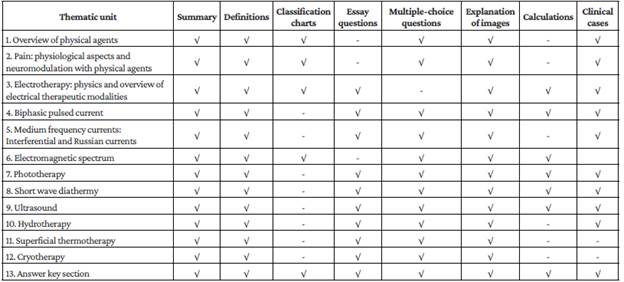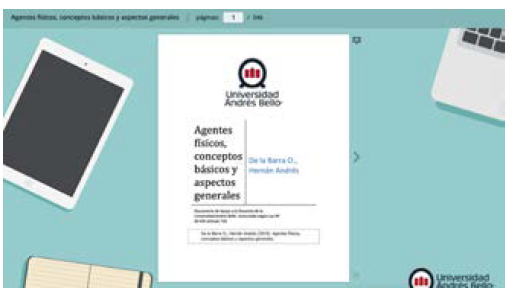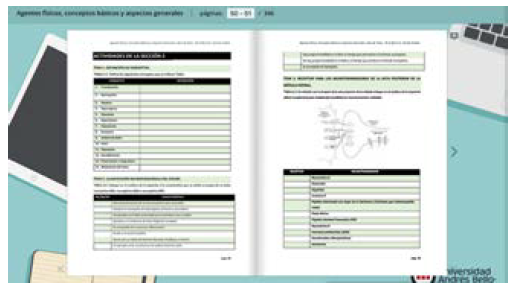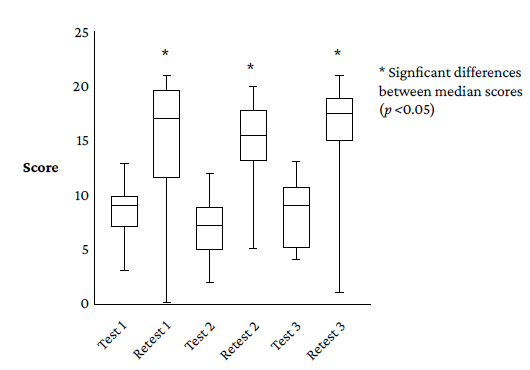Introduction
Education is undergoing a scientific and technological transformation due to globalization, a phenomenon that has greatly influenced and fostered change in higher education institutions.1 Given its role in both social policies and the development of countries, education is the engine of social mobility and a key factor to overcome poverty and inequality.2,3 The United Nations Educational, Scientific and Cultural Organization (UNESCO) World Conference on Higher Education identified the challenges and pivotal roles of higher education in the current globalized world, as well as certain key traits, such as social responsibility; access, equity, and quality; internationalization, regionalization and globalization, and learning, research and innovation, that are essential to achieve high-quality, inclusive, equitable education and to foster lifelong learning opportunities for everybody. This is not a lesser challenge, especially in the context of a pandemic such as the COVID-19, and it is an issue that is addressed in the fourth sustainable development goal.4-6
Moreover, professional training is currently undergoing a series of transformations that involve various teaching modalities, including face-to-face, blended and fully online learning, which implies the combination of learning facilitators to attain the quality standards expected at this level of education .7,8
Activities and resources of both face-to-face and online learning modalities are integrated in varying proportions to achieve the learning outcomes (LO) of a course with greater efficiency, quality and adaptability,7,9,10 thus championing a predominantly constructivist learning approach, since learners restructure their knowledge. By means of this process, new information is processed and learned.11-13 This approach focuses on students as key actors, since it makes them responsible for their own training process, yet it does not relegate the role of the instructor in terms of guidance and systematic feedback.10,12,14 Therefore, self-learning is a need to be addressed in the training process of higher education students. In turn, this need has forced many higher education institutions to adapt their learning, research, and social processes so as to align them with the use of information and communication technologies (ICTs).15-17
COVID-19 and distance learning
The coronavirus disease (COVID-19) has spread rapidly around the world since the first case was officially reported in China in December 2019.18 According to UNESCO, as of March 30, 2020, all face-to-face activities had been suspended in all schools and universities of 116 countries, and the closure of these institution had affected 87% of the student population worldwide, which amounts to 1 520 million students.19
The global health crisis caused by the COVID-19 pandemic has forced the development of remote teaching strategies.20 In the distance learning modality, teaching is regarded as a two-way communication process that replaces face-to-face interaction in the classroom. Also, several didactic resources are used together with tutorial support activities, which favors autonomous learning.21 Although content storage and interaction channels are different in online learning, current pedagogical bases may be reinforced in this learning modality by favoring the principle of interactivity or socialization.21,22 Three advantages of distance learning stand out: access to the perks of educational technology, the possibility of overcoming time-space limitations, and the feasibility of doing teamwork regardless of the real-life location of both students and instructors. This learning modality can have a positive impact on the cognitive and constructivist development of students by providing them with the possibility to choose their best learning opportunities and having the instructor guide them in their learning process.23
Among the recommendations made by UNESCO to higher education institutions in the context of the COVID-19 pandemic, the postponement of face-to-face academic activities, academic meetings and congresses stand out, which has forced universities to close their facilities. However, to ensure the continuity of education and training activities, educational institutions have been encouraged to use ICTs (e.g., online platforms, virtual campuses, or the use of interactive digital material) to resume academic activities based on an online learning approach, which has required the training of both teachers and students in the use of these technologies for educational purposes.18,24
Self-learning
Self-learning is a didactic and pedagogical strategy that effectively addresses the needs of professional training and that fosters the students' development of skills and core competencies.25-27 It is the individual learning style of any person who is able to manage their own learning process and learns new knowledge by looking up information. This pedagogical strategy enables people to "learn how to learn" by making them more aware of their cognitive process and making them think about how they learn.26,28
Self-learning becomes real when students are able to think critically and reflexively on their own. This conceptualization requires faculty members to carry out pedagogical practices that include significant learning situations, encourage problem-solving in different professional contexts,29-31 and foster critical thinking through argumentation and the development of oral and written communication skills suitable to the academic and professional fields of students.32-34 In addition, the development of the self-learning ability in students demands versatility in the teaching strategies employed if students are expected to understand the subject matter in the same way as experts do in each discipline.27 Therefore, in order to ensure an appropriate learning process, didactic strategies must be selected taking the students' needs, interests, and skills into account.35-38
The role of ICTs
ICTs allow the combination of digital information, which means it is possible to mix text with images, videos, and sounds. This capability turns ICTs into an alternative for promoting learning and self-study, all of which is possible thanks to the development of internet-based communication technologies.39-41
ICTs play a pivotal role in learning, especially in blended or distance learning modalities in the context of a pandemic, and they have been embraced for their potential to promote self-learning, highlighting the association between senses and learning.42,43 This is particularly observable in more interactive ICTs where students, besides receiving information, must carry out activities43,44 and use different technology and communication tools, as well as tools and channels, for accessing and exchanging information.45 Nowadays, students can access these resources from different devices and anywhere, which facilitates interconnectivity.40
Consequently, ICTs promote students' active roles and modify their learning process by shifting from a model focused on teaching to one focused on learning, thus following the traits of the constructivist model.46 According to UNESCO, ICTs make a major contribution to universal access to education, educational equality, and high-quality teaching and learning. In addition, they facilitate the dissemination of information, improve the quality of teaching, and guarantee the integration of the contents learned, which are essential teaching qualities in times of pandemic given the use of strict confinement and human mobility restriction measures.47
Textbook
Didactic materials are defined as any element or instrument used for teaching and learning purposes, including printed, audiovisual or multimedia resources.48 The use of these materials contributes to the building of knowledge by providing students with clearer meanings of concepts.49 Among all teaching materials, the textbook remains a learning tool that is broadly used by both teaching staff and students.49 A textbook is a structured and printed material intended to be used in a specific learning and training process that includes the information that students need to learn in order to show they have knowledge in a specific subject.50 Textbooks are also regarded as vehicles of knowledge and information that one generation wishes to transmit to the next one.50
Among the advantages of using a textbook as a learning resource, the guarantee of equal learning opportunities for students stands out, since it is a resource available to all students, which makes knowledge accessible at all times during the training process.47-50 In general, physical therapy students prefer using digital textbooks due to their convenience.50 Furthermore, digital textbooks allows instructors to identify those students that experience limitations when performing certain activities and it can be a source of academic information, learning and/or training tasks and assessment activities.48,49 Likewise, some textbooks include self-study worksheets intended to enhance discovery learning by articulating intellectual and research work techniques, as well as individual and group work activities.50
As the training of health professionals involves the development of comprehension and analytical skills, given its characteristics, the digital textbook is a didactic option that can be added and adapted to several professional training programs in health sciences.46-48
Physical agents
Physical agents are therapeutic resources that physical therapists often use in rehabilitation processes to relieve pain, reduce edema, control alterations in muscle tone, promote tissue repair and increase muscle strength, or to improve the effectiveness of other interventions aimed at solving mobility problems and promoting functional rehabilitation. They are broadly used in undergraduate physical therapy programs.51,52 The use of physical agents requires a good understanding of their biophysics, knowledge of their indications, precautions and contraindications, as well as the acquisition of skills necessary for their proper application, so it is essential for physical therapy students to develop analytical and evaluative skills when using these resources in order to guarantee their safe use and, therefore, achieve better clinical outcomes.53-60
The acquisition of analytical and reasoning skills by in-training physical therapists and their proper use of physical agents have become challenges in the context of the COVID-19 pandemic. The acquisition and development of these skills require students to understand physiological concepts, contraindications, precautions, and indications when using these resources so that their use in different clinical contexts is firmly grounded. For this reason, the digital textbook was the resource of choice to develop these skills and achieve these LOs and to integrate the knowledge related to this subject in the physical agents course offered in the physical therapy undergraduate program at Universidad Andrés Bello (Santiago, Chile).
Taking this into account, the objective of this paper is to describe, through a descriptive cross-sectional design, the design, review, digitalization and implementation phases of a digital textbook about physical agents as a learning resource to support distance learning in the training process of physical therapy students enrolled in the physical agents course offered by Universidad Andrés Bello (Santiago, Chile) in the context of the human mobility restriction measures implemented due to the COVID-19 pandemic.
Design and implementation of the digital textbook about physical agents
According to the institutional teaching model of the Universidad Andrés Bello, all courses must use active methodologies and must be oriented towards the achievement of LOs. The physical agents course is offered to fourth year physical therapy students. The course consists of three face-to-face teaching hours and six hours of autonomous work per week during 16 weeks (5 Standard Credit Transfer System -SCTS credits). In the context of the COVID-19 pandemic and due to the confinement and human mobility restriction measures implemented in Chile to slow down the spread of the virus, the physical agents course was adapted to be offered as a fully online course and was carried out as follows: a weekly 3-hour online class (synchronous work) and six hours of autonomous work per week (asynchronous work) for 16 weeks (5 ECTS credits).
The creation of the digital textbook was proposed as a guide for students to carry out the asynchronous activities of the course taking into account its accessibility and its potential to reduce knowledge-related inequalities and to reinforce the learning of the contents of the course by means of weekly self-study activities.
The digital textbook was implemented as a didactic resource to support the learning process of fourth year physical therapy students enrolled in the first semester of 2020 (March to July) in the physical agents online course.
The development of the digital textbook involved four stages: design, review, digitization, and implementation.
Design of the digital textbook
The design stage consisted of structuring both the thematic units of the textbook and the accompanying activities. A total of 13 units were developed using the contents of the course syllabus and their respective LOs.61 The digital textbook was structured so that students could attain LO 1 and LO 2 of the physical agents course syllabus, which are related to the analytic and evaluative skills involved in the use of the different types of physical agents (Table 1). LO 3 was not considered due to its procedural nature.
Table 1 Learning outcomes of the physical agents course and thematic units of the textbook.

Source: own elaboration based on the data obtained in the study.
Each thematic unit of the digital textbook was structured in two parts: a summary section and a worksheets section (Table 2).61 The summary section consisted of a general description of each topic included in the unit and where the key concepts of the contents discussed in the unit, as well as the contraindications and risks of each physical agent were highlighted. The worksheets section consisted of several self-study activities such as definitions, multiple-choice questions, interpretation and analysis of images, and development of clinical cases.61 Likewise, the complexity of the contents in each section increased according to the cognitive level of the LO to be achieved.
Table 2 Sections and self-study activities of the 13 thematic units of the digital textbook about physical agents.

√: Activity included in the unit.
-: Activity not included in the unit.
Source: own elaboration based on the data obtained in the study.
Finally, it should be noted that thematic unit 13th of the digital textbook (answer key) included the solutions to all the problems and questions included in the self-study activities, thus providing students with proper feedback at the end of each activity.
Review of the digital textbook
This phase consisted on the review of the contents of the textbook in order to ensure that there was coherence between the topics addressed and the activities included in each unit; the coordinator of the physical agents course was in charge of performing this review. In addition, a second review was conducted by expert peers for content validation purposes; likewise, this review was also intended to assess the relationship between the contents addressed in the textbook and the LOs established in the physical agents course syllabus. Finally, a third review was performed by the editorial board of the university in order to verify the textbook followed the editorial guidelines of the university.
Digitalization of the textbook
The Library of the Universidad Andrés Bello was in charge of the digitization of the textbook. Once digitized, it was uploaded to the university's digital resources archive so that students' access to it was ensured (Figures 1 and 2). It should be noted that the intellectual property of the work was registered once the digitization phase was completed.62

Source: Own elaboration.
Figure 1 Digital textbook about physical agents as an electronic learning resource (written in Spanish).
Implementation of the digital textbook
As mentioned above, once the textbook was reviewed and validated by expert peers and by the editorial committee of the Universidad Andrés Bello, it was digitized and indexed into the digital resource database of the university, where it was made available to all the students that were enrolled in the physical agents course in the first academic semester of 2020 (n=115).
Then, at the start of the course the textbook was presented to all students as a digital learning resource and they were informed on how they could access it: the textbook was available at http://recursosdigitales.unab.cl/rdigital/index.php and in order to have access to it they needed to enter their institutional credentials (example: name@uandresbello.edu and personal password). Also, an induction session was carried out to provide students with information on the contents of the textbook and how to use it during the course for asynchronous autonomous work purposes. Thus, the digital textbook was successfully introduced to students as a self-study resource of the physical agents course. Furthermore, in order to ensure students were properly using the resource, weekly feedback sessions were carried out; in these sessions, reading control activities, summative and formative tests, as well as actions aimed at solving possible doubts regarding the self-study tasks included in the textbook were performed.
In addition, to evaluate the preliminary results of the use of the digital textbook as a support learning tool for carrying out asynchronous activities and as a support resource for distance education in the training process of physical therapy students, students were asked to take a multiple-choice test that was designed taking into account both the contents included in the digital textbook and the LOs addressed by it. A test-retest analysis of three thematic units of the textbook (1, 2, 4) was also performed. The test was carried out before starting the autonomous work activities of each unit, and the re-test, after these activities were completed.
Preliminary results
Statistical analyses were performed using the STATA software (version 13.0). Scores obtained by the students in each evaluation (test and retest) were analyzed using the Shapiro-Wilk normality test to determine their distribution and, therefore, the statistical procedures and descriptive statistics to be used.63 Scores are described using measures of central tendency (medians) and measures of dispersion (interquartile ranges). Then the scores obtained in the test and the retest were compared using the U-Mann Whitney test; a significance level of p<0.05 was considered.
Scores data showed a non-normal distribution for all evaluations except for the scores in test 2 (section 2 of the textbook), so scores are presented using medians with their corresponding interquartile ranges (IQR) and representing data dispersion between the 25th and the 75th percentile (P25-P75) (Table 3). Preliminary results show a significant increase in the scores between the test and the retest in the three thematic sections of the textbook that were evaluated. Additionally, Figure 3 shows preliminary results with the scores obtained in the test and retest for thematic units 1, 2, and 4. The results show statistically significant differences between the use of the digital textbook for the three comparison instances (p<0.05), with a 9-point difference in the medians between the test-restest evaluations.
Table 3 Comparison between the scores obtained by the students in the test and retests (thematic units 1, 2 and 4).

* p-value <0.05.
† Normality analysis performed using the Shapiro Wilk test.
‡ Differences in median scores between the test and the retest were analyzed by means of the U-Mann Whitney test.
Source: own elaboration based on the data obtained in the study.
Conclusion
The digital textbook is a widely used didactic resource. On the other hand, distance learning has become more frequent at different levels of training as evidenced by the transition of most academic programs from face-to-face to online or blended learning modalities in the context of the COVID-19 pandemic.64-66
Online learning makes it possible to dismiss both time and space limitations; also, it provides access to more sources of information and allows the addition of multimedia resources that facilitate the transmission of content, all of which reinforces the principle of interactivity or socialization.40 Moreover, distance learning optimizes the training of students since it strengthens and enhances their self-learning skills as self-learning is a key element of this teaching modality.65,66
The objective of this work was to describe the design, review, digitization and implementation phases of a digital textbook as a learning resource designed to support distance learning in the training process of physical therapy students enrolled in a physical agents course, and to reinforce the achievement of two essential LOs of the course.
Preliminary results of the implementation of the digital textbook suggest that it contributed to the acquisition of LOs by the students enrolled in the physical agents course during the first semester of 2020.
The choice of this resource was based on the need to provide educational equity by offering essential information together with systematic autonomous work activities. Thus, a didactic resource was developed by mixing the learning benefits of a textbook and the perks of ICTs, which are a fundamental part of our daily lives.15,16 Digital textbooks offer a lot of advantages, including their flexibility, adaptability, interactivity, customizability, self-assessment properties and the fact they usually are easy to use andunderstand.43,65
One of the greatest challenges in the training of physical therapy students regarding the use of physical agents is attaining solid theoretical knowledge to support their proper use in clinical practice.60,61 In addition, the fact that the professors of the physical agents courses cannot easily determine the autonomous workloads (hours of dedication) of the students is a problem that must be taken into account, since it sometimes leads to an underestimation or overestimation of their work outside the classroom.66
In this regard, the digital textbook is a good learning resource since the complexity of both its contents and the activities used for the assessment of students increases progressively after completing each unit as the cognitive level required for the achievement of the LOs increases. In addition, when this type of resource is used, an emphasis on carrying out weekly learning activities is made to evenly distribute the students' workload. Furthermore, the digital textbook has a section in which feedback is provided for all of the activities it includes, which is complemented by the discussion between students and the instructor about any issues that may have occurred during the completion of such activities.67
The health crisis caused by the COVID-19 pandemic resulted in the closure of educational institutions worldwide and the need to replace of face-to-face learning by online learning at all levels of education.67-69 This shift can be seen as a learning and development opportunity for teaching staff in terms of the use of ICTs with didactic purposes, although it should be noted that virtual teaching may be restricted by the level of technological maturity of the institutions and the availability of technological resources for those involved in this experience, which conditions the quality of the process.67,68
Distance learning forces instructors to rethink their traditional teaching methodologies and reevaluate them in terms of their coherence and adaptability to this new teaching approach. This transformation opens a space for the development of creative thinking based on innovative methodologies that facilitate the attainment of LOs by students.66,69,70
The digital textbook is a valuable learning tool to guide online learning and to contextualize learning activities. In our case, it was successfully implemented as a learning strategy to improve the achievement of LOs by physical therapy students in a physical agents course that was offered in a fully online learning modality due to the restrictions implemented in Chile to slow down the spread of COVID-19. Its use implied the adjustment of the didactic strategies used in the course and the textbook provided guidelines for the execution of distance learning activities. The next stage is to wait for the consolidation of the digital textbook as a learning resource and to update and enhance the self-study units, as well as evaluate the students' level of satisfaction with it and its impact on their achievement of the LOs of the physical agents course.

















